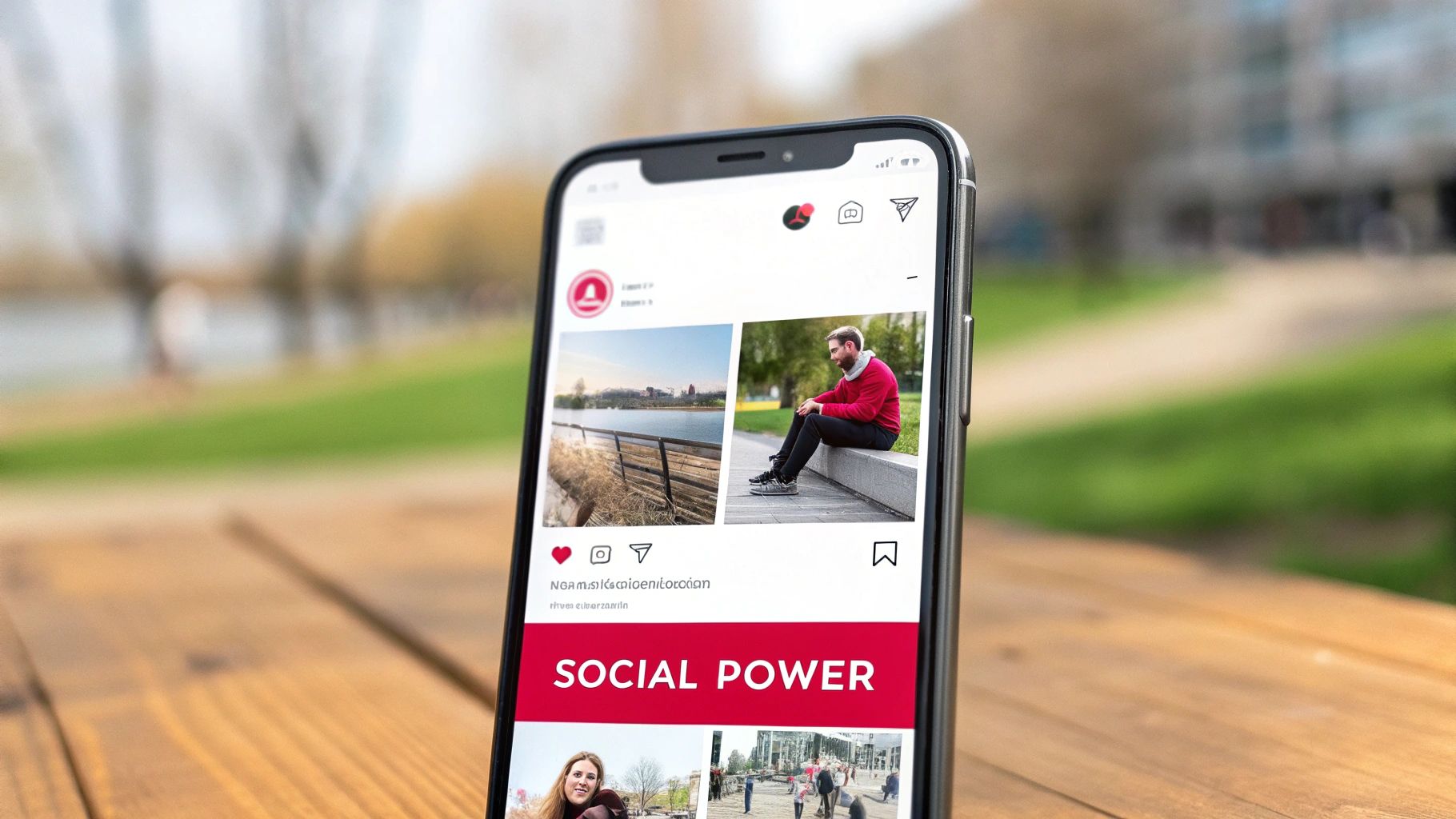
Why Traditional Branding Falls Short in Today's Digital World

A strong logo and a well-designed website were once the cornerstones of a successful brand. However, in our constantly connected world, these elements, while still important, simply aren't enough. This digital branding guide will explore why traditional branding strategies are struggling to keep up, meaning businesses must adapt to stay competitive.
Traditional branding often focused on a one-way broadcast of information. Brands communicated at their audience, not with them. Now, consumers expect interaction and personalized experiences. They want to be part of the conversation.
This shift demands a more dynamic and responsive approach to brand building. The sheer number of digital touchpoints has exploded. Consumers interact with brands across websites, social media, email, online reviews, and more.
This fragmented environment makes maintaining a consistent brand experience more challenging. Imagine telling the same story across dozens of channels, each with its unique language and audience. That's the challenge brands face today.
The digital ecosystem in California exemplifies this complexity. The vibrant, tech-driven environment, particularly in Silicon Valley, means businesses constantly experiment with new digital strategies. This fosters a rich pool of digital marketing talent and innovation, allowing companies to use technologies like AI-driven analytics and immersive VR. This dynamic landscape underscores the need for a robust digital branding strategy. Learn more about navigating the digital marketing landscape in California.
Adapting to the Digital Age
So, how can brands succeed in this new world? The answer lies in adopting a digital-first mindset. This means understanding online consumer behavior, the platforms they use, and what content resonates with them. Check out our guide on sitemap pages for a comprehensive overview of website structure for search engines and user experience.
Brands need to be more agile and adaptable. The digital world constantly evolves, and brands must adjust their strategies quickly. This might involve experimenting with new platforms, testing content formats, or rethinking their core brand message. The key is to be flexible and responsive to change.
Finally, successful digital branding requires a data-driven approach. Brands need to track their performance, analyze results, and adjust based on what they learn. This involves going beyond vanity metrics like likes and followers and focusing on metrics that impact the bottom line, like website conversions and sales. By embracing data and analytics, brands can make informed decisions and maximize their impact.
Crafting a Digital Brand Identity That Actually Resonates

In the crowded digital marketplace, a forgettable brand is a fading brand. A truly successful digital brand identity doesn't just exist; it resonates. It connects with your target audience on a deeper level, forging genuine connections that transcend surface aesthetics. This section explores how to achieve that resonance.
Understanding Your Audience: Beyond Demographics
Truly effective digital branding begins with a deep understanding of your audience. This means going beyond basic demographics and delving into their values, motivations, and pain points. What are their aspirations? What challenges do they face? Understanding these nuances allows you to tailor your messaging and create experiences that directly address their needs. For example, imagine a California-based organic food company. They might connect with health-conscious consumers by emphasizing the purity and local sourcing of their ingredients.
Defining Your Brand Voice and Positioning
Once you understand your audience, you can define your brand voice and positioning. Your brand voice is the personality and tone you project across all digital channels—the distinct way you communicate your brand's values and message. Positioning, on the other hand, focuses on differentiating your brand from the competition. What makes your brand unique? What value do you offer that others don't? This differentiation is particularly crucial in competitive markets like California.
Building a Compelling Brand Story
A compelling brand story is the key to connecting with your audience on an emotional level. Think of it as a narrative that explains your brand's purpose, values, and mission. It should be authentic and relatable, revealing the human side of your brand. A compelling narrative resonates far more powerfully than a simple list of features and benefits. Consider a California winery. They might tell a story about their family's history and dedication to sustainable winemaking, creating a deeper connection with consumers who appreciate heritage and environmental consciousness.
Visual Expression and Consistency
While emotional connection is crucial, visual consistency remains vital. Your visual identity—including your logo, color palette, and typography—should reinforce your brand voice and positioning. This doesn't necessitate rigid uniformity across every platform. Rather, it means adapting your visuals to each channel while maintaining a cohesive brand experience. Think of a California tech startup with a sleek, modern logo. Its social media graphics might utilize dynamic animations and vibrant colors, while its website maintains a clean, minimalist design, ensuring brand recognition while optimizing for each platform's user experience.
To help illustrate how these elements work together, let's examine some practical applications:
Digital Brand Identity Elements That Drive Results: A comprehensive breakdown of essential brand elements, their strategic impact, and implementation approaches with real-world California examples
| Brand Element | Strategic Impact | Implementation Approach | California Success Stories |
|---|---|---|---|
| Brand Voice | Builds personality and trust | Consistent tone across all communications | In-N-Out Burger's friendly, approachable voice |
| Brand Positioning | Differentiates from competitors | Highlight unique value proposition | Patagonia's focus on environmental sustainability |
| Brand Story | Creates emotional connection | Share authentic narratives about brand origins and values | Blue Bottle Coffee's emphasis on meticulous coffee craftsmanship |
| Visual Identity | Reinforces brand message | Consistent logo, color palette, and typography across all platforms | Apple's minimalist and modern aesthetic |
This table showcases how California brands effectively leverage various elements of their digital brand identity to achieve specific strategic goals. By focusing on consistent messaging, unique value propositions, and engaging storytelling, these brands have built strong connections with their target audiences.
Reinforcing Your Brand Promise at Every Touchpoint
Finally, every digital touchpoint—from your website and social media profiles to email communications and online reviews—should reinforce your core brand promise. Each interaction should reflect your brand's values and build trust with your audience. For example, a company prioritizing customer service should ensure prompt and helpful responses on social media, demonstrating their commitment to customer satisfaction. Maintaining this consistency builds a strong, recognizable brand identity that resonates with your audience and drives business success.
Building an Online Presence That Converts

A beautiful website and a catchy logo are simply not enough anymore. Your business needs a digital presence that drives real, tangible results. This means turning website visitors into paying customers, and ultimately, loyal brand advocates. This section of our digital branding guide explores the practical side of building online experiences that actually convert.
Prioritizing Digital Touchpoints
California businesses need a unified online presence across all channels. This cohesive approach creates seamless and positive customer journeys. Think of each interaction a customer has with your brand as a touchpoint. These touchpoints should work together, guiding the customer towards a purchase.
For example, a customer might discover your brand through an engaging Instagram post. They then visit your website to learn more about your products or services, and finally, make a purchase through your online store. Each touchpoint, from social media to your website, plays a crucial role in shaping the overall customer experience.
Prioritizing these touchpoints for your specific target audience is essential. Focus on the platforms where your ideal customers spend their time. For businesses targeting young adults, TikTok and Instagram are high priorities. LinkedIn might be more effective for B2B companies. Don't overextend your resources; instead, concentrate on the platforms with the highest potential ROI.
Optimizing for Search and Brand Consistency
Your online presence needs to be easy to find. This means optimizing your website and content for search engines like Google. Use relevant keywords, build high-quality backlinks, and create valuable content that answers your audience's questions. This will help your target customers find you organically.
At the same time, maintain brand consistency across all platforms. Your messaging, visuals, and overall brand experience should align, no matter where a customer interacts with you. This reinforces your brand identity and builds trust with your audience.
Adapting to Changing Consumer Behavior
Consumer behavior is constantly changing. Businesses must adapt their digital branding strategies to keep up with these shifts. This could involve experimenting with new content formats, integrating emerging technologies, or refocusing efforts on different platforms.
California, a hub for tech innovation, presents a unique opportunity for brands to stay ahead of the curve. California’s consumer base is highly active when it comes to digital shopping. 81% of shopping occasions begin online, and 56.5% of California residents make purchases online. This emphasizes the importance of a strong digital branding strategy. Companies like SwingPointMedia effectively use content marketing, often reducing the sales cycle by up to 70%. For more detailed statistics, see this information on digital marketing in California.
Managing Your Online Reputation
Online reputation management is crucial. Negative reviews or social media comments can significantly impact your brand image. Actively monitor your online presence, addressing any negative feedback quickly and professionally.
This shows customers you value their opinions and are dedicated to excellent service. By taking a proactive approach to reputation management, you can minimize potential damage and strengthen your brand image. Encourage positive reviews and testimonials to further enhance your online reputation and attract new customers.
Content Strategy That Establishes Genuine Authority

Many brands struggle to create content that truly resonates with their audience. This often leads to wasted effort and missed opportunities. This section explores how to develop a content strategy that not only gets read but also positions your brand as a leader in your industry. It's about understanding your audience, planning strategically, and distributing your content effectively.
Identifying Key Topics and Answering Audience Questions
Understanding your audience is the cornerstone of effective content. What are their burning questions? What challenges keep them up at night? By addressing these needs directly, you provide real value and build trust. For example, a California-based tech company could create blog posts and tutorials on the latest software developments, catering to the needs of a tech-savvy audience. This positions them as a go-to resource for valuable information. Consider exploring resources like How to master... for further guidance.
Developing a Content Calendar Aligned with Business Goals
A content calendar is your roadmap for success. It outlines the topics you'll cover, the formats you'll use (blog posts, videos, infographics, etc.), and your publishing schedule. Critically, this calendar should be tightly aligned with your overall business objectives. If your goal is increased brand awareness, focus on creating shareable content for social media platforms like Facebook and Instagram. If lead generation is your priority, consider gated content such as ebooks or webinars.
Building Effective Distribution Systems
Creating great content is only half the equation. You need to ensure it reaches the right people. This requires a robust distribution strategy. Go beyond simply posting on your website or social media. Explore email marketing, guest blogging on platforms like Medium, influencer outreach, and even paid advertising to broaden your reach. Don't forget to optimize your content for search engines like Google to boost organic visibility.
Balancing Promotional Content with Valuable Insights
Promoting your products and services is essential, but avoid overly promotional content. Instead, focus on providing genuine value to your audience. Share insightful information, offer practical advice, and address their pain points. This builds trust and establishes your brand as a helpful resource. A fitness studio, for example, could create blog posts about healthy eating habits rather than just promoting their classes.
Leveraging Subject Matter Experts
Showcasing your team's expertise is a powerful way to build authority. Feature your team members in blog posts, webinars, or podcasts. This demonstrates your company's knowledge while humanizing your brand and creating stronger connections with your audience. It also gives your team members a platform to share their passion and connect with potential customers.
Measuring Content Effectiveness
Tracking your content's performance is essential. Move beyond vanity metrics like page views and focus on meaningful metrics such as leads generated, conversions, and customer engagement. Tools like Google Analytics can provide valuable data. This data-driven approach allows you to refine your strategy and achieve your business goals.
Content Types That Build Brand Authority:
To help you plan your content strategy, let's look at some of the most effective content formats and how they can contribute to building brand authority. The following table provides a strategic analysis of content types, their best use cases, implementation difficulty, and potential ROI.
| Content Format | Brand Authority Impact | Best Use Cases | Implementation Complexity | ROI Potential |
|---|---|---|---|---|
| Blog Posts | High | Sharing industry insights, answering audience questions | Low | Medium to High |
| Case Studies | High | Demonstrating successful client outcomes | Medium | High |
| White Papers | High | Providing in-depth analysis on specific topics | High | Medium to High |
| Webinars | Medium | Engaging with audience in real-time, showcasing expertise | Medium | Medium |
| Infographics | Medium | Sharing data and statistics visually | Low to Medium | Medium |
This table offers a solid starting point for developing your content approach. Remember to select the formats that best align with your goals and target audience. Experimentation and analysis will help you fine-tune your strategy for maximum impact.
Creating Emotional Connections Through Social Channels
Many brands see social media as just a tool for broadcasting their message. But its real strength lies in building meaningful connections with your audience. This requires a shift from one-way communication to a two-way dialogue. This section explores how successful brands use social platforms to nurture genuine relationships.
Developing a Social Strategy That Resonates
A strong social media strategy needs balance. It should align your brand goals with the specific engagement styles of each platform. For instance, the visual nature of Instagram makes it perfect for showcasing products or lifestyle content. Twitter, however, is best for concise, real-time updates and quick discussions. Understanding these differences is key to tailoring your content effectively.
Your social strategy should also focus on building communities around shared values. Create content that sparks conversations and encourages interaction instead of just pushing product features. Try hosting live Q&A sessions, running polls, or creating interactive contests to increase engagement and foster a sense of belonging.
Building a loyal following takes genuine interaction. This means responding to comments, answering questions, and joining relevant conversations. This direct engagement shows your audience you value their input and are building relationships. In California, this is especially important, as 55% of consumers want brands to interact with them directly on social media. This can increase customer loyalty and influence purchase decisions. California is also a hub for top brand strategy agencies like Ruckus and Digital Silk, highlighting the focus on effective digital branding in the area. Learn more about branding statistics for marketers.
Social Listening: Uncovering Audience Insights
Social listening is the practice of actively monitoring online conversations related to your brand. This provides valuable information about your audience's needs, preferences, and concerns. By understanding what people are saying about your brand and industry, you can refine your content and messaging for better results.
Social listening also helps identify potential problems early. Addressing negative comments quickly and constructively can prevent small issues from becoming major PR nightmares. This proactive approach shows transparency and builds trust. For further insights on content creation, you might find this helpful: How to master blog content.
Converting Social Connections into Business Relationships
Building relationships is essential, but your social media activities should also support your business objectives. Use social platforms to drive traffic to your website, generate leads, and promote offerings.
However, don’t make this your only focus. Provide value to your audience by sharing insightful content, engaging in meaningful conversations, and creating a strong sense of community. By prioritizing genuine connections, you can turn followers into loyal customers and brand advocates.
This means using storytelling, showcasing user-generated content, and creating engaging experiences that resonate with your audience. Consider collaborating with influencers to expand your reach and build credibility.
Managing Negative Feedback Constructively
Not every interaction on social media will be positive. Negative feedback is unavoidable and offers a chance to showcase your dedication to customer service. Respond to criticism promptly and professionally. Offer solutions, apologize for mistakes, and actively work to fix the situation.
This demonstrates transparency and shows you value feedback. Handling negative feedback well can even turn unhappy customers into loyal supporters. By addressing concerns publicly, you demonstrate a commitment to excellent service to potential customers as well.
Measuring Brand Performance Beyond Vanity Metrics
Building a strong digital brand requires more than just likes and followers. While vanity metrics like these might create a surface-level appearance of success, they don't tell the whole story. This section explores how successful companies measure the real impact of their branding, focusing on metrics that demonstrate true business value.
Establishing Meaningful KPIs
The key to measuring brand performance effectively is establishing Key Performance Indicators (KPIs) that align directly with your brand objectives. If your goal is increased brand awareness, track metrics like reach, impressions, and share of voice.
If your primary objective is driving sales, however, focus on website conversions, lead generation, and customer lifetime value. For a California-based e-commerce business, tracking online sales and average order value would be more meaningful than social media engagement.
Implementing Tracking Systems
Choosing the right tools is crucial for collecting both quantitative and qualitative data. Website analytics platforms like Google Analytics provide invaluable data on website traffic, user behavior, and conversions.
Social listening tools can help you understand brand sentiment and identify areas for improvement. A California tourism company, for instance, could use website analytics to track traffic from different regions and understand campaign effectiveness.
Developing Reporting Frameworks
Data without context is meaningless. Develop clear reporting frameworks that communicate your brand's performance to stakeholders. This might involve creating dashboards that visualize key metrics. It could also mean generating regular reports that highlight progress toward goals or even presenting case studies.
A clear reporting structure demonstrates the return on investment (ROI) of your branding efforts, which is crucial when requesting budget or showcasing success.
Conducting Brand Audits
Regular brand audits provide a snapshot of your brand’s current position. This involves evaluating your brand's strengths and weaknesses across all digital touchpoints. A brand audit can include analyzing website performance, reviewing social media engagement, or conducting customer surveys. It can even extend to assessing competitor activity.
This helps identify areas for improvement and ensures your brand remains relevant and competitive. A California restaurant chain, for example, might find that online reviews significantly impact foot traffic, prompting them to improve their online reputation management.
Using Competitive Intelligence
Understanding your competitors is essential for effective brand building. Competitive intelligence involves analyzing your competitors' brand strategies, marketing efforts, and target audiences. These insights help identify opportunities for differentiation and competitive advantage.
For a California winery, analyzing the online marketing of other vineyards in the region could inform their own approach and highlight growth opportunities.
Continuously Optimizing Your Brand
Brand building is an ongoing process. Use data and insights to continuously refine your brand strategy, messaging, and digital presence. Regularly analyze performance data, adjust your tactics based on what you learn, and don't be afraid to experiment.
This iterative approach enables you to adapt to market changes, stay ahead of competitors, and build a digital brand that truly resonates with your target audience, in California and beyond. This constant optimization ensures your digital branding guide remains relevant and impactful.
Implementation Roadmap: Your 90-Day Brand Transformation
Transforming your digital brand isn't a quick fix; it's a strategic journey. This 90-day roadmap, inspired by successful California brands, provides a practical framework for assessing, improving, and evolving your brand's online presence. This guide breaks down the process into manageable phases, each with clear action items, resource needs, and key performance indicators (KPIs).
Phase 1: Assessment and Analysis (Days 1-30)
This initial phase focuses on understanding your current brand position and pinpointing areas for growth.
-
Brand Audit: Thoroughly review your existing digital footprint. This includes analyzing your website, social media channels, content performance, and online reputation. Customer feedback is invaluable here. This deep dive reveals your strengths and weaknesses, and identifies any gaps.
-
Competitive Analysis: Examine your competitors' digital strategies. What are they doing well? Where are they falling short? How can you differentiate your brand? Understanding the local competitive landscape is particularly important in the California market.
-
Audience Research: Gain a deeper understanding of your target audience. Go beyond demographics and explore their values, motivations, and online behavior. Tools like Google Analytics can provide helpful insights.
Phase 2: Strategy and Planning (Days 31-60)
Now that you understand your brand and audience, it's time to create a targeted strategy.
-
Define Brand Objectives: Establish SMART goals – Specific, Measurable, Achievable, Relevant, and Time-bound – for your brand transformation. These objectives should align with your overall business goals. For example, increasing online sales by 20% in the next quarter.
-
Develop Brand Messaging: Refine your core message to resonate with your target audience. Create a compelling narrative that highlights your brand's values, mission, and unique selling proposition. Consider the California market and local culture.
-
Content Strategy: Plan a content calendar that aligns with your brand objectives and audience interests. Focus on content formats that deliver value and establish your brand as an authority. Consider blog posts, videos, or infographics.
Phase 3: Implementation and Optimization (Days 61-90)
This phase puts your plan into action and continually refines it based on results.
-
Content Creation and Distribution: Start creating and distributing your planned content across relevant platforms. Don't just publish – strategically promote your content for broader reach. Consider local California publications or influencers.
-
Social Media Engagement: Actively engage with your audience on social media. Foster conversations, respond to comments, and build a community around your brand. Direct engagement is often expected by California consumers.
-
Performance Measurement and Analysis: Track your progress towards your brand objectives using relevant metrics. Analyze the data, identify what's working and what's not, and adjust your strategy accordingly. Consistent iteration is crucial for maximizing results.
Ready to transform your digital brand and make your mark in California? WebFluence Digital LLC provides the tools and resources you need to succeed. From SEO-optimized templates to conversion-driven funnels, we empower entrepreneurs and businesses to thrive online. Visit WebFluence Digital LLC today and unlock your brand's full potential.










